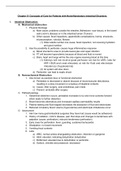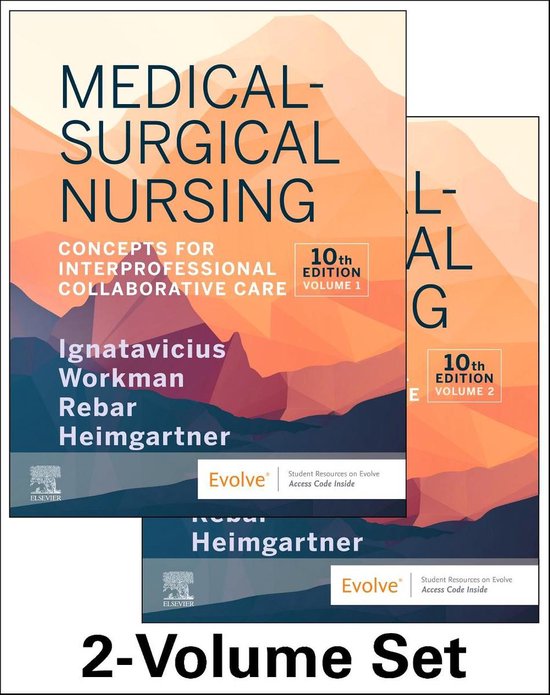Chapter 51 Concepts of Care for Patients with Noninflammatory Intestinal Disorders I.Intestinal Obstruction A.Mechanical obstruction 1.Physical blockage a)Main cause: problems outside the intestine (Adhesions- scar tissue), in the bowel
wall (crohn's disease) or in the intestinal lumen (Tumors) b)Other causes: fecal impactions, appendicitis complications, hernia, structures, intussusception, volvulus, fibrosis (1)Older adults number one cause- fecal impaction; not receiving hydration and good nutrition 2.Has the possibility to perforate- causes huge inflammatory response a)Blood shunted to area to provide leukocytes and repair infection
b)PT will become hypovolemic because all blood and fluid is moved
c)Brain, heart and lungs will be the only organs receiving blood at this time (1)Kidneys will not receive good perfusion (at risk for ARF); labs for ARF→ BUN and creat elevated; at risk for fluid and electrolyte imbalances (hypokalemia)
(2)GI system will slow down d)Peritonitis- can lead to septic shock
B.Nonmechanical Obstruction 1.Also known as paralytic ileus or functional obstruction a)Peristalsis is decreased or absent because of neuromuscular disturbance, resulting in a slow movement or a backup of intestinal contents b)Cause: After surgery, post anesthesia, pain meds c)Prevent: ambulate after surgery
C.Pathophysiology 1.Abdominal distention occurs; peristalsis increases to try and move contents forward which leads to further distention 2.Bowel becomes edematous and increased capillary permeability results 3.Plasma leaking and fluid trapped decreases the absorption of fluid and electrolytes
4.Reduced circulatory blood volume (hypovolemia) and electrolyte imbalances occur D.Assessment
1.Ask how many gastrointestinal surgeries they have had (cause would be adhesions)
2.History of radiation, crohn's disease, pain that stops and changes to tenderness with palpation (cause: perforation), rebound tenderness (perforation) 3.Early clues for perforation: fever, guarding, sustained tachycardia 4.Obstipation- no bowel movement 5.Vomiting fecal contents 6.Labs
a)WBC: normal unless strangulating obstruction, infarction or gangrene b)H&H: elevated, indicating dehydration dehydration c)BUN/creat: elevated due to dehydration or peritonitis d)Sodium, chloride and potassium: decreased e)Amylase: elevation with strangulating obstruction 7.Diagnostic
a)CT or MRI E.Complications 1.If hypovolemia is severe, acute kidney injury or death can occur F.Treatment
1.Non surgical: a)Fluid replacement and maintenance- monitor lung sounds, weight, intake and output, skin turgor, mucous membranes, vital signs b)NG tube- lots of fluid will come out and will help with decompression (1)Teach patients the risk of not receiving an NG tube (2)Keep NPO- oral care necessary (3)Tell patient to swallow or drink water (4)Chest X ray for placement (5)Check pH of gastric contents (6)NG tube with vomiting or distention- may not be in the right place
(7)Assess NG tube every 4 hours for proper placement c)NG tube care box- monitor drainage, keep NPO, semi fowler 2.Surgical a)Exploratory laparotomy- open with incision in abdomen to see cause of obstruction b)May need to resect part of the colon or colectomy G.Best practice for patients with an intestinal obstruction 1.Monitor vitals, especially blood pressure and pulse 2.Assess abdomen at least twice a day for bowel sounds, distention and passage of flatus 3.Monitor fluid and electrolyte balance 4.Management of pt with NG tube:
a)Monitor drainage, ensure tube patency, check tube placement, irrigate tube placement, irrigate as prescribed, maintain NPO, provide frequent mouth and nares care, maintain in semi-fowler position (30 degrees)
5.Give analgesics as prescribed 6.Maintain IV therapy for fluid and electrolyte replacement 7.Give Alvimopan as prescribed for pts with post op paralytic ileus
8.Maintain parenteral nutrition if prescribes II.Colorectal Cancer A.Pathophysiology
1.⅔ occur in rectosigmoid region 2.Most are adenocarcinomas- made of glandular epithelial of colon B.Risk Factors: 1.Age >50 2.Genetic predisposition 3.Personal/family history of cancer 4.Diseases that predispose- H. pylori, polyps, chrons, ulcerative colitis, HPV 5.Risk: Smoking obesity, inactivity, alcohol, a)high fat diet with red meats (increases bile acid secretion and anaerobic bacteria), high refined carb diet lacking fiber (decreased bowel transit time)
C.Health Promotion: 1.Hereditary- Genetic tensint 2.45 years or older- screening 3.Better nutrition 4.Stop smoking and drinking 5.Exercise D.Assessment 1.Signs and Symptoms
a)Vomiting, change in bowel habits, blood in bowel, occult blood, rectal bleeding, anemia, vague abdominal pain, incomplete evacuation, unintentional weight loss,
abdominal fullness b)Most common signs as it progressives; rectal bleeding, anemia, change in stool consistency and shape 2.Labs
a)Fecal occult blood test- culture comes from 2 different areas of the specimen b)Carcinoembryonic antigen- elevated (used to monitor treatment effectiveness
3.Diagnostics a)CT guided virtual colonoscopy b)Sigmoidoscopy - polyps can be removed c)Colonoscopy (definitive test)- can obtain biopsy, remove polyps
E.Treatment 1.Nonsurgical: radiation, adjuvant therapy 2.Surgical: colon resection (removal or part of colon and regional lymph nodes), or, colectomy with colostomy (partial or total) a)Ileostomy- liquid stools b)Many need colostomy- formed stool F.Colostomies- 1.Empty and ⅓ to ⅔ full 2.Risk for skin breakdown if the bag leaks 3.After- function should start in 2-3 days 4.Stoma: beefy red= good perfusion, dusky gray = poor perfusion; should be moist
5.Should protrude 1-3 cm (most common 2 cm) 6.Skin integrity- inflammation- can be caused from poorly fitted appliance, 7.Continuous heavy bleeding not good; small amount of bleeding is common
a)Problems should resolve in 6-8 weeks 8.Colostomy care box pg. 1121
III.Herniation A.Weakness of abdominal muscle wall where segment can protrude





